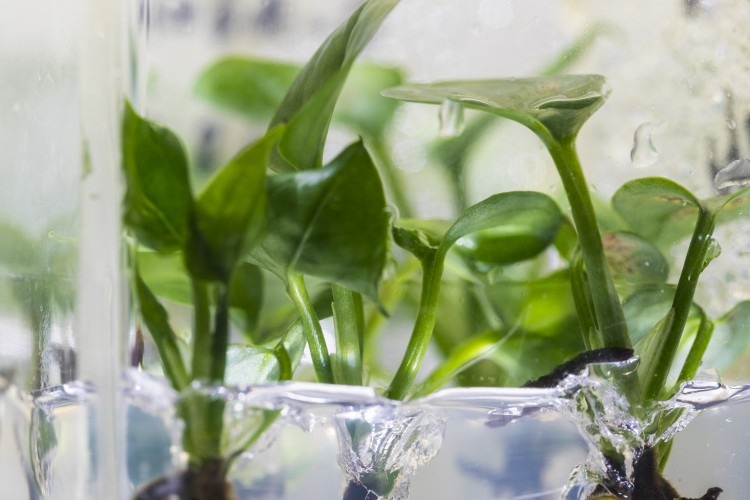Dec 20 2018
People like to maintain the air in their homes as clean as possible, and occasionally people use HEPA air filters to keep dust particles and offending allergens away.
 Researchers at the University of Washington have genetically modified a common houseplant—pothos ivy—to remove chloroform and benzene from the air around it. (Image credit: Mark Stone/University of Washington)
Researchers at the University of Washington have genetically modified a common houseplant—pothos ivy—to remove chloroform and benzene from the air around it. (Image credit: Mark Stone/University of Washington)
But certain dangerous compounds are very small to be captured in these filters. Small molecules like chloroform, which is present in tiny amounts in chlorinated water, or benzene, which is a component of gasoline, accumulate in people’s homes while showering or boiling water, or when storing cars or lawn mowers in attached garages. Both chloroform and benzene exposure has been associated with cancer.
At present, scientists at the University of Washington have genetically modified a common houseplant—pothos ivy—to remove benzene and chloroform from the air around it. The modified plants express a protein called 2E1 that alters these compounds into molecules that the plants can then use to assist their own growth. The team reported its findings in the December 19th issue of Environmental Science & Technology.
“People haven’t really been talking about these hazardous organic compounds in homes, and I think that’s because we couldn’t do anything about them,” said senior author Stuart Strand, who is a research professor in the UW’s civil and environmental engineering department. “Now we’ve engineered houseplants to remove these pollutants for us.”
The team planned to use a protein known as cytochrome P450 2E1, or 2E1 for short, which is present in all mammals, including humans. In humans, 2E1 converts benzene into a chemical called phenol and chloroform into carbon dioxide and chloride ions. But 2E1 is present in human livers and is switched on when we consume alcohol. So it is not available to help us process pollutants in the air.
We decided we should have this reaction occur outside of the body in a plant, an example of the ‘green liver’ concept. And 2E1 can be beneficial for the plant, too. Plants use carbon dioxide and chloride ions to make their food, and they use phenol to help make components of their cell walls.
Stuart Strand, Senior Author and Research Professor, Civil and Environmental Engineering Department, University of Washington.
The researchers created a synthetic version of the gene that serves as instructions for creating the rabbit form of 2E1. Then they added it into pothos ivy so that each cell in the plant expressed the protein. Pothos ivy does not flower in temperate climates so the genetically modified plants will not be able to spread via pollen.
“This whole process took more than two years,” said lead author Long Zhang, who is a research scientist in the civil and environmental engineering department. “That is a long time, compared to other lab plants, which might only take a few months. But we wanted to do this in pothos because it’s a robust houseplant that grows well under all sort of conditions.”
The scientists then tested how well their altered plants could eliminate the pollutants from air compared to regular pothos ivy. They placed both types of plants in glass tubes and then incorporated either benzene or chloroform gas into each tube. More than 11 days, the team monitored how the concentration of each pollutant varied in each tube.
For the unmodified plants, the concentration of either gas did not vary over time. But for the modified plants, the concentration of chloroform fell by 82% after three days, and it was nearly undetectable by day six. The concentration of benzene also dropped in the modified plant vials, but more gradually: By day eight, the benzene concentration had decreased by about 75%.
So as to detect these variations in pollutant levels, the scientists used much higher pollutant concentrations than are usually found in homes. But the team anticipates that the home levels would decrease similarly, if not faster, across the same time frame.
Plants in the home would also require to be kept inside an enclosure with something to push the air past their leaves, like a fan, Strand said.
“If you had a plant growing in the corner of a room, it will have some effect in that room,” he said. “But without air flow, it will take a long time for a molecule on the other end of the house to reach the plant.”
The team is presently working to boost the plants’ capabilities by incorporating a protein that can break down another unsafe molecule found in home air: formaldehyde, which is present in certain wood products, such as laminate cabinets and flooring, and tobacco smoke.
These are all stable compounds, so it’s really hard to get rid of them. Without proteins to break down these molecules, we’d have to use high-energy processes to do it. It’s so much simpler and more sustainable to put these proteins all together in a houseplant.
Stuart Strand, Senior Author and Research Professor, Civil and Environmental Engineering Department, University of Washington.
Civil and environmental engineering research technician Ryan Routsong is also a co-author. This study was sponsored by the National Science Foundation, Amazon Catalyst at UW and the National Institute of Environmental Health Sciences.